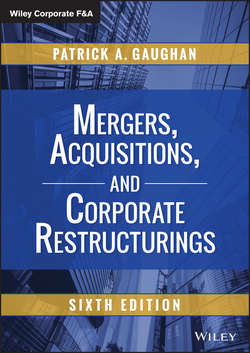Читать книгу Mergers, Acquisitions, and Corporate Restructurings - Gaughan Patrick А. - Страница 8
На сайте Литреса книга снята с продажи.
Part I
Background
Chapter 1
Introduction
Types of Mergers
ОглавлениеMergers are often categorized as horizontal, vertical, or conglomerate. A horizontal merger occurs when two competitors combine. For example, in 1998, two petroleum companies, Exxon and Mobil, combined in a $78.9 billion megamerger. Another example was the 2009 megamerger that occurred when Pfizer acquired Wyeth for $68 billion. If a horizontal merger causes the combined firm to experience an increase in market power that will have anticompetitive effects, the merger may be opposed on antitrust grounds. In recent years, however, the U.S. government has been somewhat liberal in allowing many horizontal mergers to go unopposed. That stance, however, appeared to toughen slightly when new leadership was put in place at the Justice Department following the election of Barack Obama. In Europe the European Commission has traditionally been somewhat cautious when encountering mergers that may have anticompetitive effects.
Vertical mergers are combinations of companies that have a buyer-seller relationship. A good example is the U.S. eyeglasses industry. One company, an Italian manufacturer, Luxottica, expanded into the U.S. market through a series of acquisitions. It was able to acquire retailers such as Lenscrafters and Sunglasses Hut, as well as major brands such as Ray-Ban and Oakley. It is surprising to some that the company was allowed by regulators to assume the large vertical position it enjoys in the U.S. eyeglasses market.4
A conglomerate merger occurs when the companies are not competitors and do not have a buyer-seller relationship. One example would be Philip Morris, a tobacco company, acquiring General Foods in 1985 for $5.6 billion, Kraft in 1988 for $13.44 billion, and Nabisco in 2000 for $18.9 billion. Interestingly, Philip Morris, which later changed its name to Altria, had used the cash flows from its food and tobacco businesses to become less of a domestic tobacco company and more of a food business. This is because the U.S. tobacco industry has been declining at an average rate of 2 % per year (in shipments), although the international tobacco business has not been experiencing such a decline. The company eventually concluded that the litigation problems of its U.S. tobacco unit, Philip Morris USA, were a drag on the stock price of the overall corporation and disassembled the conglomerate.
Another major example of a conglomerate is General Electric (GE). This company has done what many others have not been able to do successfully – manage a diverse portfolio of companies in a way that creates shareholder wealth (most of the time). GE is a serial acquirer and a highly successful one at that. As we will discuss in Chapter 4, the track record of diversifying and conglomerate acquisitions is not good. We will explore why a few companies have been able to do this while many others have not.
4
Patrick A. Gaughan, Maximizing Corporate Value through Mergers and Acquisitions: A Strategic Growth Guide (Hoboken, NJ: John Wiley & Sons, 2013), 160–163.
